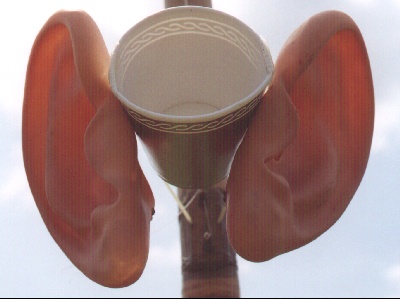
Harpe Eolienne Monocorde
: Aelian
harp with a single string : La harpe éolienne
monocorde utilise un seul fil de
nylon sous tension (diametre 0,1 à 0,8 mm) qui vibre sous
l'action du vent. Le son produit dépend de la vitesse
du vent, de la tension du fil, de sa longueur ainsi que son diamêtre.
La puissance du son est proportionnelle à la longueur
de la corde. Pour rendre audible les
sons de la corde, vous devez utiliser
un resonateur mécanique qui amplifie les vibrations :
la simple et connue "ligne téléphonique"
de notre enfance suffit. Récupérez
un verre en carton. Faites un petit
trou dans le fond. Puis passez-y un fil de coton assez raide
et faites un nœud coté intérieur du verre.
Maintenant fixez l'autre extrémité du fil de coton
à la corde de la harpe par un nœud : l'amplicateur
fonctionne dés que vous mettez en tension le fil de coton. Le vent provoque des
vibrations sur la corde de la harpe dans
un plan perpendiculaire à la direction du vent. Par
conséquent,
la meilleure orientation pour produire des vibrations sur la
corde est penpendiculaire au vent, et la meilleure direction
pour transmettre les vibrations au résonateur est perpendiculaire
à la corde et au vent. The monostring aeolian
harp uses a single monofilament Nylon-line
being under tension (diameter 0,1 to 0,8 mm) that vibrates by
the wind passing by. The sound depends on the windspeed and the
tension, the length, the diameter of the string. The power of
the sound is proportionnal to the length of the string. In order to make
hearable the sounds on the string, you must
use a mechanical resonator that amplifies the vibrations : the
simple and famous "line-telephone" of your childhood
is sufficient. Just take a cardboard
glass. Bore a little hole in the midle
of the bottom. Then fix a taut coton thread in the hole and make
a knot to the end of the thread on the inside of the glass. Now
you fixe the other end of the coton thread to the harp string
by knotting it : the amplifier functions as soon as there is
some tension on the coton thread. The wind produces
vibrations on the harp string in an area
perpendicular to the attacking wind. So, the best direction for
producing vibrations to the string is perpendicular to the wind,
and the best direction for transmitting the tones to the resonator
is perpendicular to the string and to the wind.
corde nylon de 4 mètre,
dispositif d'amplification (verre en carton
et fil transmetteur en fil coton bien raide)
nylon thread 4 meter long,
the sound is amplified by means of a
cardboard glass and a transmission
thread (made of taut coton)
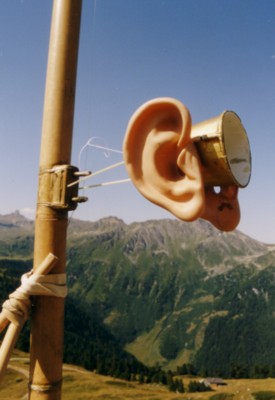
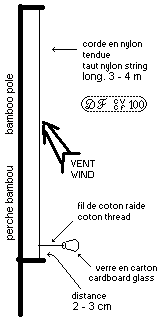
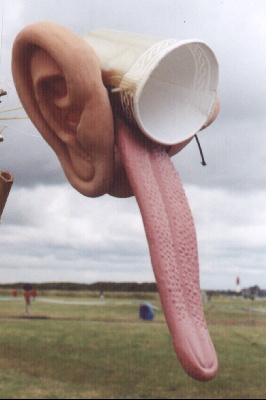

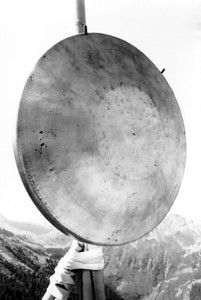 Variante : un
gong chinois comme résonateur
Variante : un
gong chinois comme résonateur
Other resonator : chinesse gong